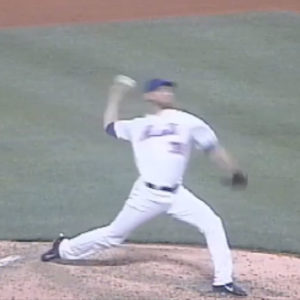 If you want to learn what it takes to develop the elite baseball pitching skill then this article will help you get started. At TopVelocity we work with all levels of baseball pitchers on performance potential and injury prevention. The open skill with intertrial variability that all my clients hope to perform is the ability to pitch a baseball at an elite level. Evidence suggests that the ability to throw a pitch at an elite speed around 90+mph is the fastest human movement recorded in a laboratory (Mcnichol, 2006). Therefore, the complexity of this motor skill is extremely high. Many continue today to study the biomechanics that defines the movement at the elite level and only a few have a complete understanding of the entire process.
If you want to learn what it takes to develop the elite baseball pitching skill then this article will help you get started. At TopVelocity we work with all levels of baseball pitchers on performance potential and injury prevention. The open skill with intertrial variability that all my clients hope to perform is the ability to pitch a baseball at an elite level. Evidence suggests that the ability to throw a pitch at an elite speed around 90+mph is the fastest human movement recorded in a laboratory (Mcnichol, 2006). Therefore, the complexity of this motor skill is extremely high. Many continue today to study the biomechanics that defines the movement at the elite level and only a few have a complete understanding of the entire process.
2 Phase Delivery for Elite Baseball Pitching
You can best define the elite baseball pitching delivery in two parts or phases; the stride phase and the throwing phase. The stride phase takes about .6-.7 seconds to complete in the elite pitcher once the hips have started to move down the pitching mound. The throwing arm is only getting into position during the stride phase to prepare itself for the throwing phase in the elite baseball pitching delivery. The throwing phase makes up the remaining .1-.2 seconds of the entire elite baseball pitching delivery and begins when the front leg lands following its leg lift which helps start the stride phase and when the throwing arm releases the pitch. Evidence suggests that elite pitchers can separate the phases more by creating a larger margin of separation between when the hip speeds peak which is helping to finish the stride phase and when the trunk speeds peak which is helping to start the throwing phase (Fortenbaugh, Fleisig, & Andrews, 2009).
Stride Phase
The first preliminary skill I would have a pitcher perform who is working to develop the movements of the elite pitcher is the same movement defined in the stride phase. This includes the back leg and front leg drives with hip rotation. Evidence suggests that the hips have been demonstrated to be the primary joint initiating spinal rotation during trunk rotation (Robb et al., 2010). Therefore, it is critical that the pitcher learn not just the sequencing of the leg drives to create hip rotation but the ground force production needed to power the spinal rotation of the upper extremity at an elite level. Ground force measurements and linear and angular joint speed metrics will help the pitcher better understand the elite forces and speeds required in the movement.
Hip to Shoulder Separation
The second preliminary skill would be hip to shoulder separation. This allows the transfer of energy from the lower extremities to the upper extremities. Kibler and Chandler (1995) calculated that a 20% decrease in kinetic energy delivered from the hip and trunk to the arm requires a 34% increase in the rotational velocity of the shoulder to impart the same amount of force to the hand. This proves how critical not only the power production is of the lower extremities but the transfer of this energy through the kinetic chain to the distal segments of the upper extremities. You can train this movement by teaching the pitcher to drive the legs and hips forward and counter the shoulders and trunk back into the lower extremity movement. Due to this counter-movement, it makes this part of the skill training very difficult. I would not move forward in the training until this counter-movement is mastered.
Throwing Phase
The third and final preliminary skill would be the throw. This would involve training the glove arm side to help trigger trunk rotation while acting as a fulcrum for trunk rotation and the throwing arm side to get into position to best support the trunk dynamics. The goal is to train the throwing arm to become a force regulator or a funnel and not a force generator. The pinnacle movement in the timing of the release of energy to the ball is when the kinetic energy meets the internal rotation velocity of the throwing arm. If this conversion is not precise then velocity and accuracy iarecompromised.
Once all three of the preliminary skills have been mastered the pitcher can begin to combine all the skills into one movement. This will take time to create consistency of the timing from segment to segment and may require going back to the preliminary skills if needed. The goal is to optimize each segment of the kinetic chain as it moves through the pitching delivery to achieve an elite level of performance for the individual athlete.
Elite Baseball Pitching Reference:
- Fortenbaugh, D., Fleisig, G., & Andrews, J. (2009). Baseball Pitching Biomechanics in Relation to Injury Risk and Performance. Sports Health, 4, 314–320.
- Kibler, W., & Chandler, J. (1995). Baseball and Tennis. Griffin LY, editor, 219-226.
- Mcnichol, T. (2006). The Ultimate Pitching Machine. Wired. Retrieved from https://www.wired.com/2004/06/strikeout/
- Robb, A., Fleisig, G., Wilk, K., Macrina, L., Bolt, B., & Pajaczkowski, J. (2010). Passive ranges of motion of the hips and their relationship with pitching biomechanics and ball velocity in professional baseball pitchers. American Journal Sports Medicine, 38, 2487-93.



